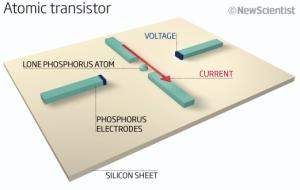
The basic unit of matter could become the basic unit of computing. A lone atom of phosphorus embedded in a sheet of silicon has been made to act as a transistor. (from newscientist1.blogspot.de)
It is not the first single-atom transistor, but it can be much more precisely positioned than its predecessors, potentially making it a lot more useful.
“It’s an absolutely fantastic piece of engineering,” says physicist Bruce Kane at the University of Maryland, who was not involved in the work.
Elaborate production methods would initially prevent single-atom phosphorus transistors from being a worthwhile addition to traditional computers, but they may be necessary one day. The devices could also find an application in futuristic, super-speedy quantum computers.
A transistor is essentially a lump of conducting material sitting between two electrodes that acts as a switch. A pulse of voltage is supplied by a further electrode,”opening” the switch and allowing current to flow through the transistor.
Wiggling atom
Combining transistors on a chip produces logic circuits that can carry out computations. A goal shared by computer chip makers is to keep shrinking the transistor: squeeze ever more onto a single chip and you increase its computational power.
To dictate the exact position of their single atom, Michelle Simmons at the University of New South Wales, Australia, and colleagues started by covering a silicon sheet with a layer of hydrogen. Then they used the tip of a scanning tunnelling microscope to remove hydrogen atoms according to a precise pattern. They exposed two perpendicular pairs of exposed silicon strips plus a tiny rectangle made of just six silicon atoms that sat at the junction between these strips (see diagram, right).
Adding phosphine gas (PH3) and heating caused phosphorus atoms, which are conducting, to bind to these exposed areas of silicon. In the case of the rectangle only one atom inserted itself into the silicon network.
The result was four phosphorus electrodes and a single phosphorus atom.
Boutique operation
One pair of electrodes was separated by a 108-nanometre gap. Creating a voltage between them allowed current to flow between the two perpendicular electrodes – separated from each other by just 20 nanometres, through the single phosphorus atom, which acted as a transistor.
Kane points out that the atomic transistor works at temperatures below 1 kelvin and that fabrication is difficult. “It’s a very slow, boutique operation to make one of these,” he says.
Simmons agrees, but counters that the traditional computer makers may be forced to adopt this technology if they want to make ever smaller chips. “This is one of the only techniques that allows you to make single atom devices,” she says.
Physicist Jeremy Levy of the University of Pittsburgh in Pennsylvania reckons the future of single atom transistors lies in quantum computers. The spin of the electrons in isolated phosphorus atoms could serve as qubits, the quantum equivalent of the bits in today’s computers. Controlling the interaction between qubits requires knowing the exact location of each one. Now that the location of individual atoms can be controlled, the next challenge is to link two of these transistors, Levy says.
